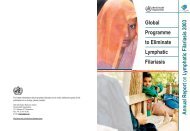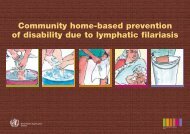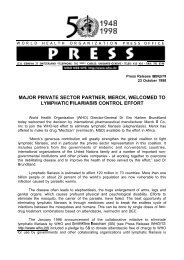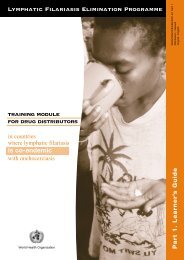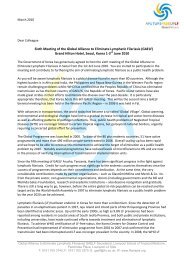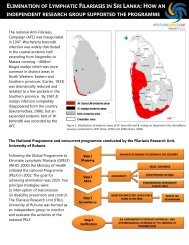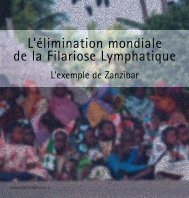English - Global Alliance to Eliminate Lymphatic Filariasis
English - Global Alliance to Eliminate Lymphatic Filariasis
English - Global Alliance to Eliminate Lymphatic Filariasis
Create successful ePaper yourself
Turn your PDF publications into a flip-book with our unique Google optimized e-Paper software.
REPORT OF THE 6 TH GAELF MEETING, JUNE 2010<br />
The GPELF had its origins following the<br />
World Health Assembly (WHA) resolution<br />
50.29, passed in 1997, which urged<br />
member states <strong>to</strong> eliminate LF as a public<br />
health problem. WHO published a<br />
strategic plan for LF elimination in<br />
September 1999, and the GAELF held its<br />
first meeting in 2000 in Santiago de<br />
Compostela, Spain. WHO is currently<br />
preparing a report that will review<br />
progress from 2000 <strong>to</strong> 2009 and lay out a<br />
strategic plan for LF elimination for 2010-<br />
2020.<br />
The GPELF set as its goal the global<br />
elimination of LF as a public health<br />
problem by 2020, <strong>to</strong> be achieved through<br />
two major strategies: 1) s<strong>to</strong>pping the<br />
spread of infection through MDA; and 2)<br />
reducing the burden of disease through<br />
morbidity management.<br />
A stepwise programmatic strategy <strong>to</strong><br />
interrupt transmission has been<br />
recommended, beginning with mapping<br />
<strong>to</strong> assess areas where MDA is needed;<br />
followed by five or more years of MDA<br />
using a combination of two drugs for<br />
every eligible individual in endemic areas.<br />
This is followed by a period of post-MDA<br />
surveillance; and, ultimately, verification<br />
of LF elimination. Currently, 81 countries<br />
are considered endemic for LF, with 1.34<br />
billion persons at risk of infection and 120<br />
million infected. Of the <strong>to</strong>tal global<br />
burden, 65% is found in the Southeast<br />
Asia Region of WHO (SEAR), followed by<br />
the Africa Region (AFR), with 35%.<br />
As shown in the figure below, of the 81<br />
endemic countries, 10 (12.3%) are unlikely<br />
<strong>to</strong> require MDA based on current<br />
assessment and 52 (64.2%) currently have<br />
active MDA programmes.<br />
Progress <strong>to</strong>wards LF elimination and status of mass drug administration in 81 LF-endemic countries, by WHO region<br />
WHO<br />
Region/<br />
PRG<br />
LF<br />
endemic<br />
countries<br />
Estimated<br />
Population at<br />
risk (2009)<br />
MDA status of LF endemic countries<br />
Countries<br />
under<br />
MDA<br />
(2009)<br />
Countries<br />
unlikely <strong>to</strong><br />
require<br />
MDA<br />
Countries<br />
completed<br />
≥ 5 rounds<br />
(end of<br />
2009)<br />
Targeted<br />
population by<br />
MDA (end of<br />
2009)<br />
Cumulative<br />
number of<br />
treatment<br />
(200-2009)<br />
AFR 39 408,429,756 18 5 10 104,963,306 273,952,117<br />
AMR 7 11,349,793 4 3 3 5,922,193 12,532,495<br />
EMR 3 12,565,325 2 2 565,325 14,125,271<br />
SEAR 9 873,264,167 9 7 965,216,694 2,328,231,443<br />
MEK 6 32,115,887 5 1 4 25,890,680 95,478,249<br />
PAC 17 5,813,842 14 1 11 2,991,746 8,515,528<br />
<strong>Global</strong> 81 1,343,538,770 52 10 37 835,549,944 2,732,895,102<br />
19



